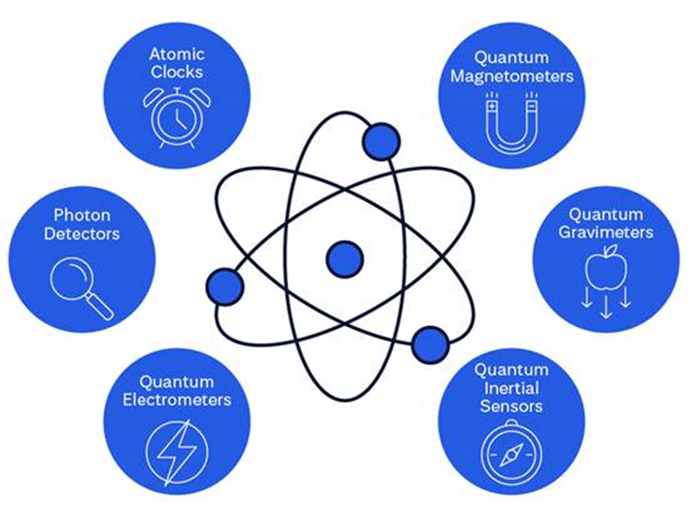
A recent report from Citi Global Insights looks at quantum sensors, hypersensitive sensors that have wide-ranging and potentially profound applications.
The quantum sensing market is burgeoning, with $80 million invested by venture capital in quantum sensing companies in 2023. Quantum sensors rely on quantum particles to make measurements. They have the potential to be many orders of magnitude more sensitive to their environment than traditional sensors, opening a huge range of applications, and unlocking new data and insights to power decision making.
Third party TAM forecasts for quantum sensing range between $300 million to $1.4 billion by 2030, with an average compound annual growth rate (CAGR) of almost 15%. But proprietary analysis by Citi Global Insights suggests this significantly underestimates the potential of the quantum sensing market. In fact, in a new report, CGI says that a market of $3.25-5bn could develop for just one type of quantum sensor, in the aviation industry alone. The report looks at the profound benefits that quantum sensors could bring to society across uses ranging from navigation to healthcare, defence to agriculture and beyond, as well as potential challenges ahead.
Figure 1. Types of Quantum Sensors
© 2024 Citigroup Inc. No redistribution without Citigroup’s written permission.
Source: Citi Global Insights
- Atomic Clocks: These are the most accurate timekeeping devices ever created. They rely on the precise frequency of radiation emitted or absorbed by certain atoms as they transition between different energy states.
- Quantum Magnetometers: These measure magnetic fields with high precision. They can detect very tiny changes in magnetic fields several orders of magnitude smaller than classical magnetometers.
- Quantum Gravimeters: These measure the strength of local gravitational acceleration using quantum interference. They offer the possibility of significantly greater precision.
- Quantum Inertial Sensors: These consist of quantum accelerometers and quantum gyroscopes, which measure changes in linear acceleration and rotation using the principles of quantum interference.
- Quantum Electrometers: These measure electric fields, such as the radio frequency waves used by effectively all modern communication devices. They are expected to have much higher sensitivity than classical electrometers.
- Photon Detectors: These have an ability to detect individual packets of light, called photons. This, for instance, can enable three-dimensional imaging based on the time it takes a photon to travel between an object and detector.
The full report has sections on each of these types of quantum sensors, with select examples of where these technologies could be applied.
There doesn’t appear to be any agreed-upon size for the current TAM for quantum sensing at this point, however, with 2023 estimates varying by a factor of almost 6x, ranging anywhere from around $150 million to $850 million. The CAGR estimates range from around 5% on the lower end to more than 25% on the upper end.
One of the reasons for this, the report says, are the different maturity levels of the different quantum sensing technologies, and the consequent uncertainty in industry applications are likely contributing factors to the highly divergent market size forecasts.
Some of the estimates for the total quantum sensing market size below are considerably less than the market size estimate of $500 million through atomic clocks.
Given the large variations in the current TAM, forecasts by the end of the decade vary by around $1.1 billion, translating to a variation of 5x. To put this into context, Citi’s literature review of quantum computing found that it had an average TAM of around $750m 2023 and average forecast growth rate of 30% - twice that of quantum sensing. However, as mentioned, the potential TAM just for quantum inertial sensors in aircraft could be in the region of $3.25-$5bn – significantly higher than the current forecast from research houses.
The extreme precision quantum sensors offer could revolutionize fields like geology, navigation, and medicine. For example, in geology, they could provide more accurate data for natural resource exploration, leading to more efficient mining and oil extraction processes. This precision could result in significant cost savings and reduce the environmental impact.
Quantum sensors could also lead to the development of ultra-precise navigation systems. This would benefit autonomous vehicles, shipping, and aviation, reducing accidents and improving efficiency. The economic impact of safer and more efficient transportation systems is substantial, from decreased insurance costs to less downtime due to accidents.
In healthcare, quantum sensors might enable early detection of diseases at a molecular level. This could lead to timely interventions, reducing the overall cost of healthcare and improving patient outcomes. The economic implications here are vast when considering the global expenditure on healthcare.
For more information on this subject, and if you are a Velocity subscriber, please see the full report (originally published on 23 February 2024) here: Quantum Sensing - Tech’s New Eyes and Ears
Citi Global Insights (CGI) is Citi’s premier non-independent thought leadership curation. It is not investment research; however, it may contain thematic content previously expressed in an Independent Research report. For the full CGI disclosure, click here.
